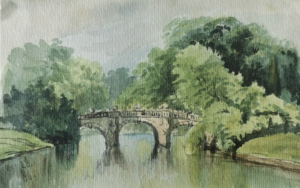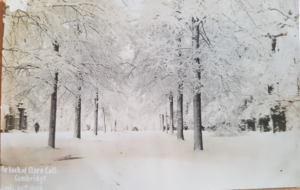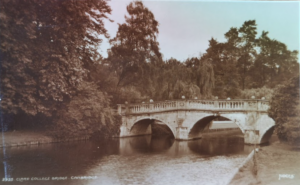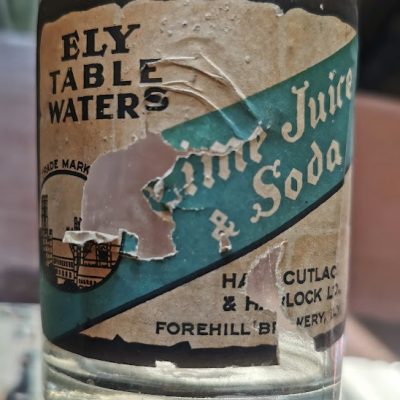Search by topic
- archaeology
- Building of Local Interest
- chapel
- charity
- church
- crime
- dressmaker
- fire
- Great Eastern Railway
- Listed building
- Mapping Relief
- medieval
- oral history
- poverty
- Public House
- Religious House
- Roman
- scholar
- school
- Then and Now
- tudor
- women
- work
- world war one
- world war two
Search by text
 Clare College bridge by Henry Moule, 1887 (MoC10/147/51)
Clare College bridge by Henry Moule, 1887 (MoC10/147/51)Clare College (University Hall)
History of Clare College Cambridge
Lady Elizabeth de Clare refounded Richard de Badew’s University Hall as Clare College in 1338, but nothing remains of the medieval buildings. The college was rebuilt, starting in 1638 and continuing until 1719, creating a single rectangular court, Old Court, with designs influenced by Sir Christopher Wren. Clare Bridge was built over the River Cam 1638-40, giving access to the gardens on The Backs, the first bridge at Cambridge in Classical style, and the oldest surviving bridge in the city.
General information about Clare College can be found on Wikipedia.
It was first founded in 1326 as University Hall by Richard de Badew, Chancellor of the University. However the foundation did not prosper and in 1338 Elisabeth de Burgh, sister and co-heir of Gilbert, Duke of Clare, came to its aid with her patronage.
The life of Elizabeth de Burgh, Lady of Clare, of Clare is told in great detail in ‘For her Good Estate‘ by Frances A Underhill, pub.2020. Elizabeth’s links to the religious houses at Anglesey Abbey and Denny Abbey can be noted.
1703
Robert Greene was born in Tamworth around 1678 and was admitted to Clare College in 1695. He became a Fellow in 1703 and in the same year became vicar of Everton near Sandy until his death in 1730. As a Fellow he published views which were very antagonistic to other theories of the day, such as those of Sir Isaac Newton. he made provision on his death that a bookshelf of his works was to be erected at Clare College, memorials to him were to be put at four locations in Cambridge, and that his body was to be dissected and that all the fragments, except the bones were to be buried in All Saints Church.
In the end Clare College didn’t comply with any of Green’s requests and it was only in 1742 that six scholarships were set up from the money he had left. Greene’s bones were not displayed at the college; instead another skeleton was substituted. The final resting place of this skeleton was not the library, as Greene had intended but a cupboard at the top of a staircase near the hall. The skeleton may have been destroyed in a fire at Clare in 1890. But it may also have been stolen, bone by bone, by students prior to this. However, the prizes in his name, the Greene Cups, continue to be awarded. (Cambridge College Ghosts by Geoff Yeats)
1801
Lucy Walker, Chair of the Board of Trustees shares.
“In the kitchen at the Museum of Cambridge, one of my favourite objects sits on a shelf with some other fascinating food preparation items – including what may be one of the earliest mechanical food mixers on the shelf above.
This machine is a thing of beauty, made of heavy-duty steel, with precision engineering, and a handle to turn a chain which links to cogs to move its various parts, with levers and pins. However, until I read the label, I had no idea what it is! The label describes it as an apple corer and peeler, dating to the late 19thcentury, and apparently it once belonged to Clare College, part of the University of Cambridge. Perhaps the catering staff kindly donated it as they were upgrading their kitchens.
It was made by S Nye & Co (London), and its style is very much of the 19thcentury, pre-electric, and highly engineered – redolent of much larger machinery designed to do much bigger jobs around the world. It is hand turned, but it’s easy to imagine a bigger version powered by steam! I’ve googled apple corers and peelers, and they are still made today – with the added bonus of slicing – but none are as magnificent as this.
Just looking at the machine in the museum you realise it is a solid bit of kit intended to do a big job. As the handle is turned a central projection would remove the core and turn the apple round as a blade peeled it. Clever. But was it over-engineered? Well maybe! Particularly as I think you can only core and peel one apple at a time. However, you just have to think of its context to realise that it certainly needed to be heavy duty. Imagine all those students who needed feeding every day, and the number of apples required for sauces and to fill pies and crumbles for their puddings throughout the year. That gives you an idea of how significant a piece of kitchen equipment it was!”
1932
Contribute
Do you have any information about the people or places in this article? If so, then please let us know using the Contact page or by emailing capturingcambridge@
License
This work is licensed under CC BY-NC-SA 4.0
























